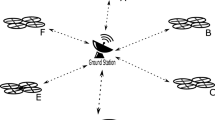Abstract
In order to support precision formation flying missions, distributed spacecraft require inter-spacecraft communications with required performance. We present a hierarchical network architecture that supports both time-criticality for updating relative navigation measurements and flexibility for implementing various phases of mission operations. The architecture incorporates a reactive routing protocol with timely topology status, an enhanced IEEE 802.11 media access control protocol meeting the quality of service requirements, and single carrier-frequency domain equalization technique for reducing energy consumption. Our simulation results show that the proposed network architecture provides a fair tradeoff between time-criticality of services and flexibility of network topology among spacecraft.









Similar content being viewed by others
References
Scharf, D. P., Keim, J. A., & Hadaegh, F. Y. (2010). Flight-like ground demonstrations of precision maneuvers for spacecraft formations—part I. IEEE Systems Journal, 4, 84–95.
Sanjeeviraja, T., & Dash, P. K. (2012). Estimation of precision formation flying using position of the spacecraft. In 2012 IEEE aerospace conference (pp. 157–160).
Alagoz, F., & Gur, G. (2011). Energy efficiency and satellite networking: A holistic overview. Proceedings of the IEEE, 99, 1954–1979.
El-madany, H. T., Fahmy, F. H., El-Rahman, N. M. A., & Dorrah, H. T. (2011). Spacecraft power system controller based on neural network. Acta Astronautica, 69, 650–657.
Sun, Z. (2014). Satellite networking. New York: Wiley.
Marcos, A. (2005). Bergamo. High-throughput distributed spacecraft network: Architecture and multiple access technologies. Computer Networks, 47, 725–749.
Liu, X., & Kumar, K. D. (2012). Network-based tracking control of spacecraft formation flying with communication delays. IEEE Transactions on Aerospace and Electronic Systems, 48, 2302–2314.
Ilcev, S. D. (2011). Code division multiple access (CDMA) applicable for mobile satellite communications. In Control and communications (SIBCON) (pp. 224–227)
Ali-Yahiya, T. (2011). Understanding LTE and its performance. New York: Springer.
Clare, L. P., Gao, J. L., Jennings, E. H., & Okino, C. (2005). A network architecture for precision formation flying using the IEEE 802.11 MAC protocol. In Aerospace conference, 2005 IEEE (pp. 1335–1347).
Si, L., Bingcai, C., & Lan, Y. (2010). A modified 802.11 protocol applicated in space wireless local area network. In 2010 International conference on computer design and applications (ICCDA) (Vol. 2, pp. V2-585–V2-588).
Mirrezaei, S. M., Faez, K., & Ghasemi, A. (2014). Performance analysis of network coding based two-way relay wireless networks deploying IEEE 802.11. Wireless Personal Communications, 76, 41–46.
Geng, R., Guo, L., & Wang, X. (2012). A new adaptive MAC protocol with QoS support based on IEEE 802.11 in ad hoc networks. Computers & Electrical Engineering, 38, 582–590.
Luzio, M., Dinis, R., & Montezuma, P. (2012). SC-FDE for offset modulations: An efficient transmission technique for broadband wireless systems. IEEE Transactions on Communications, 60, 1851–1861.
Silva, F., Dinis, R., & Montezuma, P. (2014). Channel estimation and equalization for asynchronous single frequency networks. IEEE Transactions on Broadcasting, 60, 110–119.
Lei, L., Zhong, Z., Lin, C., & Shen, X. (2012). Operator controlled device-to-device communications in LTE-advanced networks. IEEE Wireless Communications, 19, 96–104.
Yi, X., Sun, Z., Yao, F., & Miao, Y. (2013). Satellite constellation of MEO and IGSO network routing with dynamic grouping. International Journal of Satellite Communications and Networking. doi:10.1002/sat.1032;31:277C302.
Perkins, C. E., Royer, E. M., Das, S. R., & Marina, M. K. (2001). Performance comparison of two on-demand routing protocols for ad hoc networks. IEEE Personal Communications, 8, 16–21.
Bianchi, G. (2000). Performance analysis of the IEEE 802.11 distributed coordination function. IEEE Journal on Selected Areas in Communications, 18, 535–547.
Zhao, L., Wu, J. Y., Zhang, H., & Zhang, J. (2008). Integrated QoS differentiation over IEEE 802.11 WLANs. Journal of IET Communications, 2, 329–335.
Bianchi, G., & Tinnirello, I. (2003). Kalman filter estimation of the number of competing terminals in an IEEE 802.11 network. In INFOCOM.
Zhao, L., Zou, X., Ding, W., Zhang, H., & Zhang, J. (2008). Game-theoretic cross-layer design in WLANs. In IEEE international wireless communications and mobile computing conference (pp. 570–575).
Kennedy, J., & Eberhart, R. (1995). Particle swarm optimization. IEEE International Conference on Neural Networks, 4, 1942–1948.
Zhao, L., Gao, L., Zhao, X., & Ou, S. (2013). Power and bandwidth efficiency of wireless mesh networks. IET Networks, 2(3), 131–140.
Acknowledgments
The work was partly funded by the 111 Project (B08038), EU FP7 Project MONICA (PIRSES-GA-2011-295222), National Natural Science Foundation of China (No. 61372070), and the Open Research Fund of National Mobile Communications Research Laboratory, Southeast University (2012D01).
Author information
Authors and Affiliations
Corresponding authors
Rights and permissions
About this article
Cite this article
Liang, K., Zhao, L., Liu, Y. et al. Enhanced IEEE 802.11 MAC Protocol for Precision Formation Flying-Based Distributed Spacecraft. Wireless Pers Commun 79, 375–388 (2014). https://doi.org/10.1007/s11277-014-1862-4
Published:
Issue Date:
DOI: https://doi.org/10.1007/s11277-014-1862-4




